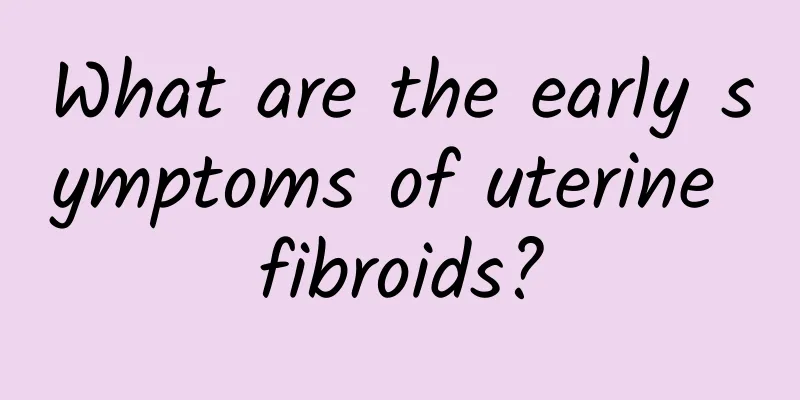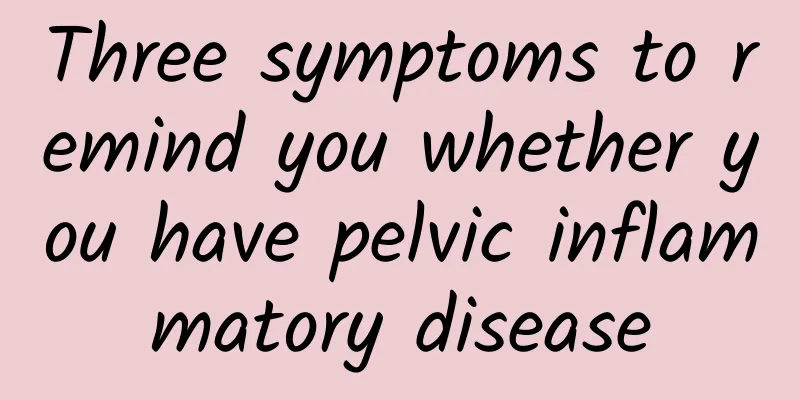What are the early symptoms of uterine fibroids?

|
What are the early symptoms of uterine fibroids? This is what many female patients want to know. In order to prevent and treat uterine fibroids in time, we invite experts on uterine fibroids to answer us. What are the early symptoms of uterine fibroids? The early symptoms of uterine fibroids are: (1) Uterine bleeding: Clinically, it can manifest as menorrhagia, cyclical bleeding, increased menstrual volume, and often accompanied by prolonged menstruation. This type of bleeding is the most common; frequent menstruation, shortened menstrual cycle, increased menstrual volume; irregular bleeding, loss of normal menstrual periodicity, long duration, sometimes more and sometimes less, and continuous bleeding, which is more common in submucosal fibroids. Uterine bleeding is more common in submucosal fibroids and intermuscular fibroids, and subserosal fibroids rarely cause uterine bleeding. (2) Abdominal mass: The uterus is located deep in the pelvic cavity, and the mass cannot be felt in the abdomen when the fibroids first appear. When uterine fibroids gradually increase in size, the uterus exceeds the size of a 3-month pregnancy, or the subserosal fibroids located at the bottom of the uterus are easier to touch from the abdomen. The mass is located in the middle of the lower abdomen, solid, movable but not very mobile, without tenderness, and grows slowly. If the patient's abdominal wall is thick, the uterus is enlarged, or it exceeds the pelvic cavity and even reaches the size of a 4-5-month pregnancy, it is still difficult for the patient to find it by herself. Therefore, few patients with uterine fibroids seek medical treatment due to abdominal masses. Huge submucosal fibroids prolapse outside the vagina, and patients may seek medical treatment due to prolapse of the vulva. Tumors are often accompanied by infection and necrosis, and such patients have been rare in recent years. (3) Vaginal discharge: Uterine submucosal fibroids or cervical submucosal fibroids can cause increased vaginal discharge. Once the tumor is infected, there may be a large amount of purulent vaginal discharge. If there is ulceration, necrosis, or bleeding, there may be bloody or purulent vaginal discharge with a foul odor. (4) Compression symptoms: Uterine fibroids can cause compression symptoms of surrounding organs. Uterine anterior wall fibroids close to the bladder can cause bladder irritation symptoms, manifested as frequent urination and urgency; when cervical fibroids grow forward to a considerable size, they can also cause bladder compression, leading to upper pubic discomfort, frequent urination, urinary retention or overflow incontinence; giant cervical anterior lip fibroids filling the vagina and compressing the urethra can cause dysuria and even urinary retention. Patients may seek medical attention due to urinary system symptoms. Uterine posterior wall fibroids, especially giant fibroids in the isthmus or posterior lip of the cervix, fill the vagina and compress the rectum backwards, causing posterior pelvic distension and constipation. Broad ligament fibroids or giant cervical fibroids develop laterally and embed into the pelvic cavity, compressing the ureter and causing obstruction of the upper urinary tract, resulting in ureteral dilatation and even hydronephrosis. It is rare for lower limb edema to occur due to obstruction of pelvic lymph and venous blood flow caused by fibroid compression. (5) Pain: Generally, uterine fibroids do not cause pain symptoms. If pain symptoms occur, it is mostly caused by pathological changes in the fibroids themselves or combined with other pelvic diseases. (6) Infertility and miscarriage: Most patients with uterine fibroids can conceive and carry their pregnancies to term. However, some women of childbearing age are infertile and cannot find other reasons other than fibroids. They become pregnant after myomectomy, indicating that infertility is related to fibroids. The location, size, and number of fibroids may have a certain impact on conception and pregnancy outcomes. Cervical fibroids may affect the entry of sperm into the uterine cavity; submucosal fibroids may hinder the implantation of fertilized eggs; giant primary uterine fibroids deform the uterine cavity, especially the interstitial part of the fallopian tube is squeezed by fibroids and blocked, hindering the passage of sperm; some people believe that uterine fibroids cause congestion and dilation of the muscle wall and endometrial veins, especially the endometrium, which results in an intrauterine environment that is not conducive to the implantation of fertilized eggs or insufficient blood supply to embryonic development, leading to miscarriage. (7) Anemia: The main symptom of uterine fibroids is uterine bleeding. Long-term excessive menstruation or irregular bleeding can lead to hemorrhagic anemia. Clinically, there are different degrees of anemia symptoms. Severe anemia is more common in submucosal fibroids. Severe anemia, especially for a long time, can cause myocardial nutritional disorders. (8) Erythrocytosis: Uterine fibroids are rarely associated with erythrocytosis. Most patients are asymptomatic. The main basis for diagnosis is increased hemoglobin and red blood cell counts. No other cause of erythrocytosis can be found except uterine fibroids. After tumor resection, hemoglobin and red blood cells return to normal. (9) Hypoglycemia: Hypoglycemia associated with uterine fibroids is also rare. The main manifestations are low fasting blood sugar, loss of consciousness and shock. The symptoms can completely disappear after glucose injection. The symptoms of hypoglycemia completely disappear after tumor resection. After consultation with the gynecologist, the uterus was enlarged to the size of a 4-month pregnancy, hard, smooth, and limited in movement. There was an egg-sized cyst in the right ovary. A subtotal hysterectomy and right adnexectomy were performed. No abnormalities were found in the pancreas during the operation, and the hypoglycemia disappeared after the operation. The above content explains the early symptoms of uterine fibroids. I hope everyone can pay attention to it. If you have early symptoms of uterine fibroids, please go to the hospital for treatment in time. Do not delay treatment, which may cause serious consequences. If you have any questions about uterine fibroids, please consult our online experts for answers. Uterine fibroids http://www..com.cn/fuke/zgjl/ |
<<: What are the precautions for vulvar leukoplakia
>>: What are the types of uterine fibroids?
Recommend
What are the nursing measures for hospitalization of ectopic pregnancy?
The nursing measures for ectopic pregnancy mainly...
Cheers to the Universiade! Drinking alcohol while watching the game may cause premature aging of the skin
Are you ready for the Taiwan Universiade on Augus...
Don’t be picky about New Year’s dishes! Weight may increase by 2 kg after the new year
This pork trotter with dried bamboo shoots is shi...
Healthy living can prevent the occurrence of functional uterine bleeding
Nowadays, it is not uncommon for adolescent girls...
Causes of Dysmenorrhea
Dysmenorrhea refers to pain in the lower abdomen ...
Symptoms of cervical precancerous lesions in women
Female cervical precancerous lesions usually have...
Treatment of irregular menstruation for female white-collar workers should start with daily diet
Irregular menstruation is a common problem for wh...
How to know whether the gestational sac has been expelled in spontaneous abortion
In case of spontaneous abortion, you can determin...
Local treatment of cervical hypertrophy
Local treatment of cervical hypertrophy can be do...
What tests should be done for chronic cervicitis?
Through the speculum, the diagnosis can be made b...
Drinking coffee is very harmful to women with dysmenorrhea
Drinking coffee is a habit of modern urban women....
Preliminary analysis of the etiology of hyperprolactinemia
The cause of hyperprolactinemia needs to be activ...
What are the specific symptoms of pelvic inflammatory disease?
The incidence of pelvic inflammatory disease is g...
Can vulvar itching be cured?
Many women do not want to suffer from vulvar prur...
What happens if uterine fibroids compress the bladder during pregnancy?
A few months into my pregnancy, I went to the hos...









